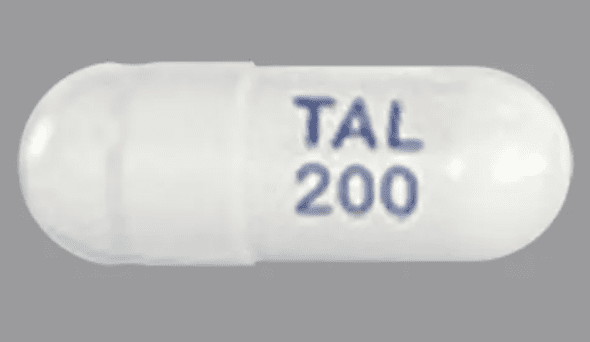Taletrectinib Dosage
Medically reviewed by Drugs.com. Last updated on Jul 8, 2025.
Applies to the following strengths: 200 mg
Usual Adult Dose for:
Additional dosage information:
Usual Adult Dose for Non-Small Cell Lung Cancer
600 mg orally once a day on an empty stomach
Duration of therapy: Until disease progression or unacceptable toxicity
Comments:
- Select patients for the treatment based on the presence of ROS1 rearrangement(s) in tumor specimens; a US FDA-approved test to detect ROS1 rearrangements is not currently available.
- Administer at least 2 hours before and 2 hours after food intake.
Use: For the treatment of locally advanced or metastatic ROS1-positive non-small cell lung cancer
Renal Dose Adjustments
Renal dysfunction: Data not available
Liver Dose Adjustments
LIVER DYSFUNCTION: Data not available
HEPATOTOXICITY:
Stepwise Dose Reductions for Hepatotoxicity:
- First dose reduction: 400 mg orally once a day
- Second dose reduction: 200 mg orally once a day
- If unable to tolerate 200 mg/day: Permanently discontinue therapy.
Grade 3 ALT or AST elevation greater than 5 to 20 times the upper limit of normal (5 to 20 x ULN): Withhold therapy until recovery to grade 1 or less, or baseline.
- If resolved within 6 weeks, resume at a reduced dose level.
- If not resolved after 6 weeks, permanently discontinue therapy.
- For recurrence: If resolved within 6 weeks, resume at a reduced dose level.
- For recurrence: If not resolved after 6 weeks, permanently discontinue therapy.
Grade 4 ALT or AST elevation greater than 20 x ULN: Withhold therapy until recovery to grade 1 or less, or baseline.
- If resolved within 6 weeks, resume at a reduced dose level.
- If not resolved after 6 weeks, permanently discontinue therapy.
- For recurrence: Permanently discontinue therapy.
For ALT or AST at least 3 x ULN with concurrent total bilirubin at least 2 x ULN (in the absence of cholestasis or hemolysis): Permanently discontinue therapy.
Dose Adjustments
Stepwise Dose Reductions for Adverse Reactions:
- First dose reduction: 400 mg orally once a day
- Second dose reduction: 200 mg orally once a day
- Permanently discontinue therapy in patients unable to tolerate 200 mg orally once a day.
INTERSTITIAL LUNG DISEASE (ILD)/PNEUMONITIS:
Grade 1: If ILD/pneumonitis occurs or is suspected, withhold therapy until recovery to grade 0 or baseline.
- If resolved within 6 weeks, resume at the same dose level.
- If not resolved after 6 weeks, permanently discontinue therapy.
- For recurrence: Permanently discontinue therapy.
Grade 2: If ILD/pneumonitis occurs or is suspected, withhold therapy until recovery to grade 0 or baseline.
- If resolved within 6 weeks, resume at a reduced dose level.
- If not resolved after 6 weeks, permanently discontinue therapy.
- For recurrence: Permanently discontinue therapy.
Grade 3 or 4: Permanently discontinue therapy.
QTc INTERVAL PROLONGATION
Grade 2 QTc interval 481 to 500 milliseconds (msec): Withhold therapy until recovery to at least grade 1 or baseline.
- Correct electrolytes and/or change concomitant medications.
- Resume therapy at the same dose.
Grade 3 QTc interval 501 msec or greater, OR QTc interval increase of more than 60 msec from baseline: Withhold therapy until recovery to at least grade 1 or baseline.
- Correct electrolytes and/or change concomitant medications.
- Resume therapy at a reduced dose level.
Grade 4 (e.g., Torsade de pointes, polymorphic ventricular tachycardia, signs/symptoms of serious arrhythmia): Permanently discontinue therapy.
HYPERURICEMIA:
Grade 3 or 4: Withhold therapy until improvement in signs or symptoms.
- Resume therapy at the same or reduced dose level or permanently discontinue treatment.
CREATINE PHOSPHOKINASE (CPK) ELEVATION:
CPK greater than 5 x ULN: Withhold therapy until recovery to baseline or at least 2.5 x ULN, then resume therapy at the same dose.
- For recurrence: Withhold until recovery to baseline or at least 2.5 x ULN, then resume at a reduced dose.
CPK greater than 10 x ULN: Withhold until recovery to baseline or at least 2.5 x ULN, then resume at a reduced dose.
OTHER ADVERSE REACTIONS:
Grade 3: Withhold therapy until recovery to at least grade 1 or baseline.
- If resolved within 6 weeks, resume therapy at a reduced dose level.
- If not resolved after 6 weeks, permanently discontinue therapy.
- For recurrence: Resume therapy at a reduced dose, or permanently discontinue
Grade 4: Withhold therapy until recovery to at least grade 1 or baseline.
- Once resolved, resume therapy at a reduced dose level or permanently discontinue as clinically indicated.
- For recurrence: Permanently discontinue therapy.
Precautions
CONTRAINDICATIONS: None
Safety and efficacy have not been established in patients younger than 18 years.
Consult WARNINGS section for additional precautions.
Dialysis
Data not available
Other Comments
Administration advice:
- Before initiating treatment, evaluate liver function tests (including ALT, AST, and bilirubin), electrolytes, electrocardiogram (ECG), and uric acid.
- Administer therapy orally at the same time each day on an empty stomach (with no food intake at least 2 hours before and 2 hours after administration); avoid grapefruit during therapy.
- Capsules should be swallowed whole; do not crush, chew, or open/dissolve the capsule contents.
- If a dose is missed or vomiting occurs anytime after dosing, administer the next dose at its scheduled time on the following day.
Storage requirements:
- Store at 20C to 25C (68F to 77F); excursions are permitted to 15C to 30C (59F to 86F).
General:
- This drug may cause photosensitivity; sun protection is recommended during treatment and at least 5 days after discontinuation.
Monitoring:
- Cardiovascular: ECG (at baseline, then periodically as indicated during therapy; more often with risk factors)
- Hepatic: Liver function tests, including AST, ALT, and bilirubin (at baseline, every 2 weeks during the first two months, then monthly as indicated during therapy; more often if transaminase elevations occur)
- Metabolic: Electrolytes and serum uric acid (at baseline, then periodically as indicated during therapy)
- Musculoskeletal: Serum creatinine phosphokinase (every 2 weeks during the first month of therapy, then as indicated for muscle symptoms)
- Pulmonary: For new or worsening pulmonary symptoms (during therapy)
Patient advice:
- Read the US FDA-approved patient labeling (Patient Information).
- Avoid food or drink containing grapefruit during treatment.
- Minimize sun exposure and use sun protection, including broad-spectrum sunscreen, during treatment and for at least 5 days after discontinuation.
- Understand that laboratory testing is needed before and periodically (or as indicated) during treatment.
- Report any signs or symptoms of hepatotoxicity, worsening pulmonary function, QT prolongation, hyperuricemia, unexplained muscle pain, tenderness, or weakness, and/or bone fractures to your health care provider.
- Breastfeeding is not recommended during treatment.
- Patients of childbearing potential: This drug may cause potential harm to a fetus.
- Notify your health care provider of a known/suspected pregnancy.
- Females: Use effective contraception during treatment and for 3 weeks after the last dose.
- Males (with female partners of reproductive potential): Use effective contraception during treatment and for 3 weeks after the last dose.
More about taletrectinib
- Check interactions
- Compare alternatives
- Side effects
- During pregnancy
- Drug class: multikinase inhibitors
- En español
Patient resources
Other brands
Professional resources
Other brands
Related treatment guides
See also:
Further information
Always consult your healthcare provider to ensure the information displayed on this page applies to your personal circumstances.


